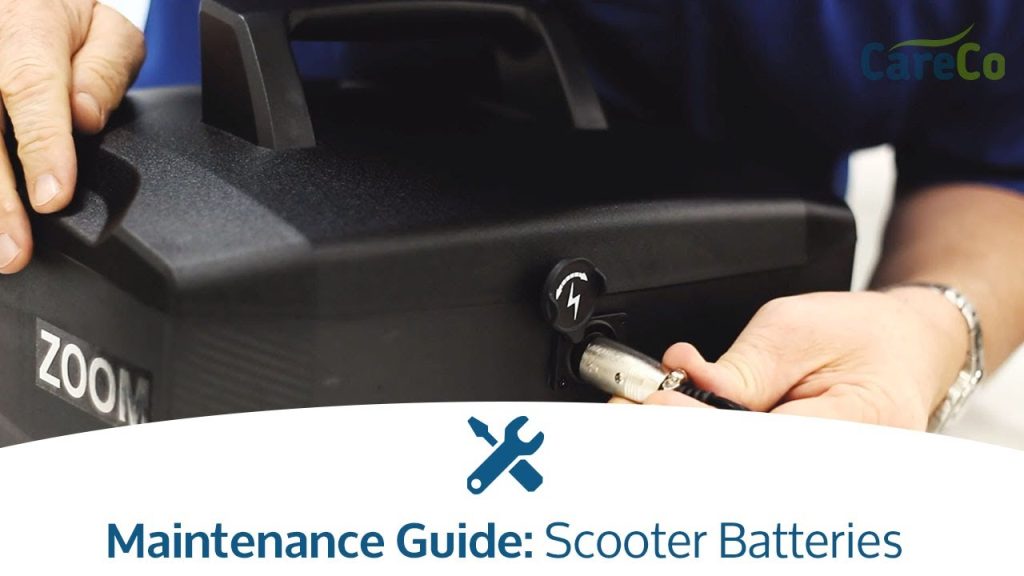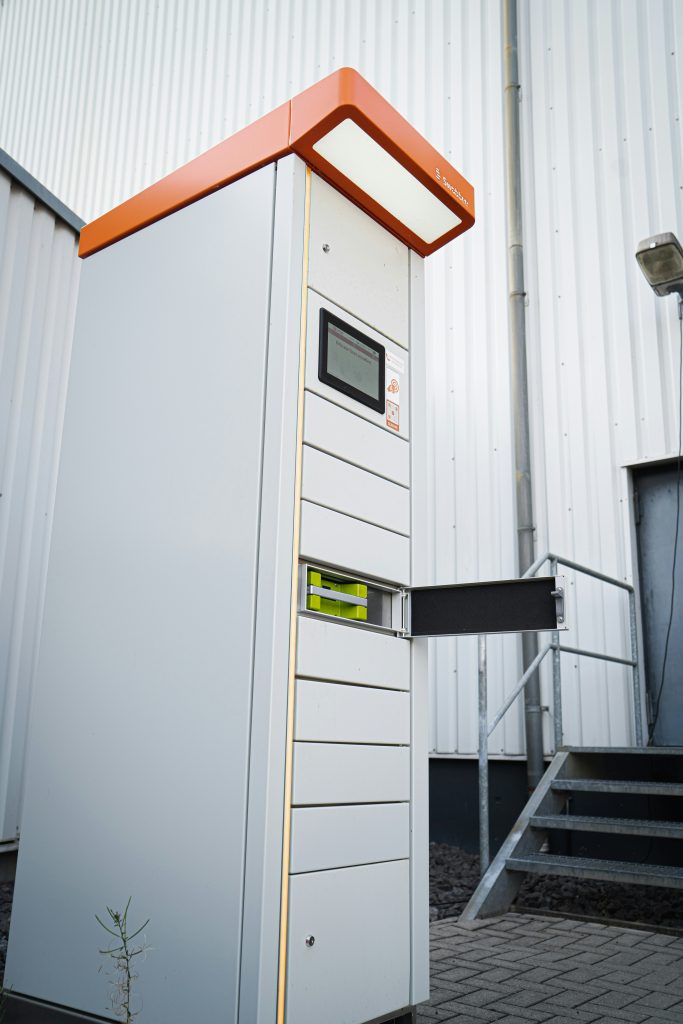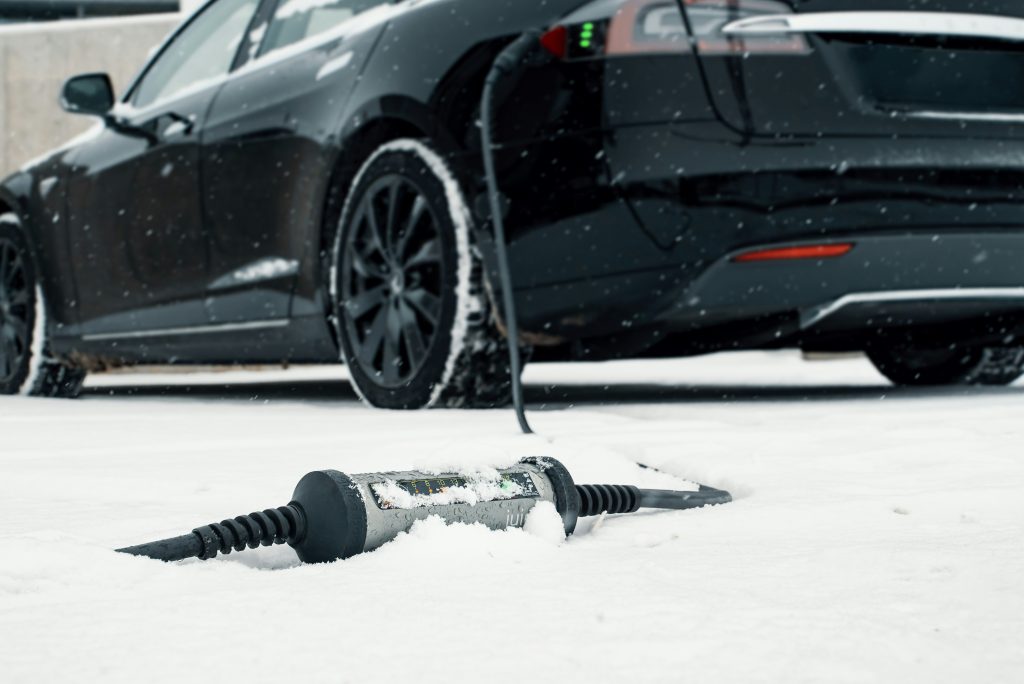Keep your mobility scooter or powerchair running reliably by learning how to care for its battery. This guide and the CareCo video explain the different battery types and sizes and show proper charging steps, safe storage, and simple maintenance you can do at home.
You’ll find step-by-step charging procedures, tips to extend battery life, and clear answers to common questions so you can feel confident handling routine care. If you need extra help or personalised advice, call 0800 111 4774.

Understanding Mobility Scooter Batteries
You rely on your scooter or powerchair battery to get you where you need to go, so it helps to understand the basics. This section gives you a clear picture of the common battery chemistries you’ll find, how voltage and capacity affect range, how to read labels and specs, and quick ways to identify the battery in your machine.
Common battery types used in mobility scooters and powerchairs such as sealed lead-acid (SLA), AGM, gel and lithium‑ion
Most mobility scooters and powerchairs use one of a few common battery types. Sealed lead‑acid (SLA) batteries are the traditional choice: they’re robust, inexpensive and tolerant of variable charging, but they’re heavy. Absorbent Glass Mat (AGM) and gel batteries are both types of valve‑regulated lead‑acid (VRLA) batteries; AGM uses a glass mat to hold electrolyte and usually tolerates higher discharge rates, while gel uses a gelled electrolyte and can be more vibration resistant but may require slightly different charging voltages. Lithium‑ion batteries are lighter and have much higher energy density, giving more range for less weight; they also typically include a battery management system (BMS) that protects against overcharge, overdischarge and imbalance. Each chemistry has pros and cons for weight, lifespan, maintenance and cost.
How battery voltage and amp‑hour (Ah) capacity affect range and performance
Voltage and amp‑hour (Ah) ratings are the two key numbers that determine how your scooter will perform. Voltage (commonly 12V, 24V, 36V systems, etc.) determines the electrical potential available to the motor and controls speed and power; higher system voltages often support stronger motors or more efficient drive systems. Amp‑hour capacity tells you how much charge the battery stores — higher Ah generally means more range. Roughly speaking, range is proportional to Ah (and affected by motor efficiency, rider weight, terrain and speed). For example, two 12V 50Ah batteries wired to make 24V will give you more usable energy than the same system with 30Ah batteries. Remember that usable capacity can be less than rated capacity if you regularly discharge deeply or let batteries age.
How to read battery labels and specifications
Battery labels usually list the chemistry (SLA, AGM, Gel, Li‑ion), nominal voltage (e.g., 12V), capacity in Ah (e.g., 50Ah), manufacturing date or code, and often a part or model number. You may also find recommended charging voltages or maximum charge current. For lithium packs you might see cell count or nominal pack voltage (e.g., 12.8V, 25.6V). If a charger specification is printed on the label, it’s important to follow it. If any specification is unclear, check your scooter’s owner’s manual for the exact battery requirements rather than guessing.
How to physically identify the battery type in your scooter or powerchair
You can usually identify a battery by visual and physical clues. Lead‑acid batteries are heavy, have a rectangular block shape, and carry labels stating 12V and Ah values; they may have vent caps on non‑sealed designs (though many are sealed VRLA). Gel batteries often explicitly say “gel” on the label. AGM batteries will be sealed but may be labeled AGM or VRLA. Lithium packs are much lighter for the same capacity, often have a plastic housing with model/chemistry labeling and sometimes visible BMS wiring or connectors. If you’re unsure, remove the battery cover (with the machine off) and read the label, or consult your owner’s manual.
Importance of Proper Charging
Proper charging is one of the single most important actions you can take to preserve battery life and keep your scooter reliable. This section explains why correct charging matters, the risks of doing it wrong, and how your charging habits influence long‑term performance and warranty coverage.
How correct charging preserves battery life and maintains range
Charging correctly — using the right charger, following recommended charge times, and avoiding extreme states of charge or discharge — helps batteries maintain capacity and deliver predictable range. Lead‑acid batteries benefit from regular charging and occasional full charges to balance their cells; lithium packs maintain longevity when charged with a charger that follows the manufacturer profile and stops at the proper voltage. Proper charging reduces stress on the battery chemistry, slows capacity fade, and helps ensure your scooter performs consistently day to day.
Risks of improper charging such as reduced capacity, damage or safety hazards
Incorrect charging can shorten battery life, reduce usable capacity, or in worst cases cause physical damage or safety hazards. Overcharging lead‑acid batteries can cause gassing, heat and internal damage; undercharging can lead to sulfation and reduced capacity. For gel batteries, excessive charging voltage can cause irreversible damage. Lithium batteries charged improperly (too high voltage, incorrect current profile or without proper BMS control) can overheat, swell or even catch fire. Using the wrong charger can therefore be both costly and dangerous.
How charging habits affect long‑term performance and warranty
Manufacturers often set warranty terms that assume you will use the correct charger and follow specified charging routines. Using aftermarket chargers that don’t match the recommended voltage or charging profile, or repeatedly running batteries to deep discharge, can void warranties. Good habits — regular charging after use, avoiding deep discharges, and storing batteries charged to recommended levels during long periods — will extend life and keep warranty claims straightforward if an issue arises.
Preparing to Charge
Before you plug in, take a few simple steps to make charging safe and effective. This section covers the safety checks, basic shutdown procedures, terminal cleaning and the importance of reading the manual.
Safety checks before charging: inspect cable, charger and battery for damage
Before charging, inspect the charger cable, plug and the battery for visible damage such as fraying, exposed wires, cracked housings, bulging or leaking. If you spot any physical damage, don’t use the charger or battery — get them examined by a qualified technician. Also confirm the charger is the one intended for your scooter and that its rating matches your battery’s requirements.
Turn off the scooter or powerchair and set parking brake where applicable
Always switch your scooter or powerchair off and, if it has one, set the parking brake before connecting the charger. Turning the vehicle off reduces the risk of electrical faults and prevents vehicle components from being powered while you connect or disconnect the charger. It’s a simple step that lowers the chance of sparks or accidental movement.
Clean battery terminals and connectors to ensure good contact
Dirty, corroded or loose terminals cause poor charging, increased resistance and heat buildup. Before charging, inspect and, if needed, clean terminals with a wire brush or terminal cleaner and a cloth. If you see white or greenish corrosion, remove it carefully (wear gloves and eye protection). For sealed batteries, avoid getting moisture into vents or connectors. After cleaning, ensure connections are tight and secure.
Read the owner’s manual or battery label for any model‑specific instructions
Always take a moment to read your scooter or battery manual for specifics: recommended charger type, charging times, storage voltage, and any warnings. Some batteries or scooters have model‑specific quirks — for example, chargers that require you to plug into the scooter before plugging into the mains or vice versa. Following the manufacturer’s instructions protects the battery, maintains warranty and keeps you safe.
Choosing the Right Charger
Using the right charger is essential. This section helps you decide between manufacturer and aftermarket chargers, explains how to match voltage and current, clarifies smart charger features, and highlights the importance of connector compatibility.
Use of manufacturer‑supplied chargers versus compatible aftermarket chargers
Manufacturer‑supplied chargers are designed for your specific battery chemistry and scooter electronics, so they are the safest bet. Good quality aftermarket chargers can also be acceptable if they exactly match the battery’s specifications and are from reputable makers. Avoid cheap generic chargers without clear specs or protections — they can mischarge batteries and increase risks.
Matching charger output voltage and current to battery specifications
Make sure the charger’s output voltage matches your battery pack voltage (e.g., a 24V charger for a 24V pack). The charger current (amps) should be appropriate for the battery’s capacity; a typical guideline is a charge current of around 0.1C (10% of battery Ah) for lead‑acid batteries, though manufacturers may recommend different rates. Higher‑current chargers charge faster but can generate heat and stress the battery if they exceed recommended rates. Always follow the battery or scooter manual for exact values.
Understanding smart chargers and automatic cut‑off features
Smart chargers monitor battery voltage and charge state, adjust current through stages (bulk, absorption, float) and automatically cut off or switch to a maintenance mode when fully charged. These features prevent overcharging, prolong battery life and can safely maintain batteries in long‑term storage. For lithium batteries, smart chargers communicate with the BMS and use precise protocols to stop charging at the correct voltage.
Connector types and ensuring a secure fit
Chargers connect via a variety of plugs, from round barrel plugs to three‑pin connectors or bespoke sockets on the scooter. Make sure the charger connector fits securely and that there’s no wobble or corrosion in the port. A loose connection can lead to intermittent charging, heating and connector damage. If your connector is worn, replace it before continuing regular charging.

Step‑by‑Step Charging Procedure
Follow a deliberate charging routine to stay safe and get the most out of your battery. This section provides a clear step‑by‑step process you can follow each time.
Switch off scooter and ensure it is parked on a stable, level surface
Before charging, turn the scooter or powerchair off and park it on a stable, level surface. This prevents accidental movement and makes it easier to access the charging port. Using the parking brake if available is a sensible extra precaution.
Connect the charger to the scooter’s charging port before plugging into the mains (or follow manufacturer recommendation)
Many manufacturers recommend connecting the charger to the scooter first, then plugging the charger into the mains to avoid sparks or surges. However, follow the exact sequence your owner’s manual specifies — some chargers are designed to be plugged into the mains first. Consistently following the manufacturer’s recommended sequence reduces risk and avoids triggering charger protection features.
Plug the charger into the mains and observe LED indicators for charging status
Once connected, plug the charger into the mains and watch the charger indicators. Most chargers have LEDs or meters showing charging, full charge, fault or standby. A steady or pulsing red/amber usually means charging, green often means full or maintenance mode, and flashing patterns can indicate faults — check your charger’s legend or manual to interpret the lights.
Allow the battery to charge to full; check charger lights or meter to confirm completion
Let the charger run until it indicates the battery is fully charged. For smart chargers that switch to float or maintenance mode, you can leave it connected if the manufacturer allows; for older or manual chargers, unplug promptly when full to avoid overcharging. If your scooter has a battery level indicator, you can monitor it too, but rely primarily on the charger’s completion signal.
Unplug the mains first, then disconnect the charger from the scooter
When charging is complete, unplug the charger from the mains before disconnecting it from the scooter — unless your manual recommends the opposite. This reduces the risk of sparks near the scooter’s connectors. After disconnecting, store the charger and cables safely to avoid damage.
Charging Best Practices and Schedule
Developing good routines keeps your battery healthy and your scooter ready. This section outlines frequency recommendations, topping up, typical charging times, and when to do full charge cycles.
Recommended charging frequency: after every day of moderate use or according to manufacturer guidance
A practical rule is to recharge after each day of moderate use — topping up keeps batteries near full and avoids deep discharge. If you use the scooter lightly or infrequently, consult the manual for storage charge levels; some manufacturers recommend charging at least once every few weeks during storage to prevent self‑discharge from dropping the battery too low.
Avoiding deep discharge by topping up between uses
Deep discharges stress batteries and shorten life, especially with lead‑acid chemistries. Topping up between uses keeps the battery in a healthier state of charge and ensures you have range when needed. With lithium batteries, occasional shallow cycles are fine; avoid letting them sit at very low charge for long periods.
Typical charging times for different battery sizes and types
Charging time depends on battery Ah and charger current. As a rough example, a 12V 50Ah battery charged with a 5A charger takes roughly 10 hours (50Ah ÷ 5A) plus some extra time for inefficiencies, so plan for 10–12 hours. A 24V 50Ah pack with a 5A 24V charger will take proportionally longer. Lithium batteries may charge faster with higher‑current chargers designed for them, but always follow manufacturer maximums. Smart chargers will taper current near full charge, so final topping stages take longer.
When to perform full charge cycles versus partial top‑ups
You should perform regular full charge cycles occasionally for lead‑acid batteries to prevent imbalance and sulfation — for example, a full charge every 1–2 weeks if you top up daily. For lithium packs, full cycles are less critical and it’s often better to avoid consistently charging to 100% if long cycle life is the goal (check manufacturer guidance). Use a full cycle if the battery gauge seems inaccurate or if you’re about to store the battery long‑term.

Charging Safety Precautions
Safety comes first when dealing with batteries and mains electricity. These precautions help you reduce fire, chemical and electric shock risks while charging.
Charge in a well‑ventilated, dry area away from flammable materials
Charge in a dry, ventilated area so any small amounts of gas produced by lead‑acid batteries can disperse. Keep chargers and batteries away from curtains, paper, petrol, or other flammable materials. Ventilation is less critical for sealed batteries but is still good practice.
Do not charge on soft surfaces that retain heat or block ventilation
Avoid charging on beds, sofas or thick carpets where heat can build up and airflow around the charger or battery is restricted. Place the scooter or battery on a hard, stable, non‑flammable surface like concrete or a floor mat.
Use only the correct charger and mains voltage for your scooter
Always match the charger to your battery’s voltage and chemistry, and use a mains supply of the correct voltage and frequency. Using an improper charger or plugging into the wrong mains voltage can damage the charger, battery or scooter electronics and may present a fire hazard.
Do not leave chargers plugged in unsupervised for extended periods if manufacturer warns against it
If your charger or manual advises against leaving the charger connected indefinitely, don’t leave it unattended for long periods. While many smart chargers have maintenance modes, some older chargers do not safely auto‑cutoff and could overheat or overcharge if left connected.
Charging Troubleshooting
When charging problems arise, a methodical approach can often resolve them. This section gives you checks to perform and signs that professional help is needed.
What to do if the charger LED does not illuminate or the battery won’t charge
If the charger LED stays off or the battery won’t charge, first check that the mains socket works by plugging in another device. Confirm the charger is properly connected to the scooter. If the socket is fine and connections are good, the charger or battery may be faulty.
Common causes of no charge: faulty charger, blown fuse, corroded terminals, poor connections
Common reasons for no charging include a faulty charger, a blown mains fuse or inline fuse on the scooter, corroded terminals, or a loose connector. Inspect these items carefully and replace blown fuses with the correct rating. Clean terminals and try a different socket before assuming the battery is dead.
Interpreting charger indicator lights and error codes
Consult the charger manual or label to interpret LEDs or error blink codes — they commonly indicate charging, full, battery fault, reverse polarity, or short circuits. If the charger shows a fault code, follow the recommended corrective steps in the manual or contact support.
Steps to take before seeking professional help: try a different mains socket, check fuses, clean connections
Before calling for service, try simple checks: use a different known‑good mains outlet, check and replace any fuses, ensure all connectors are clean and tight, and inspect for any visible damage. If you have a multimeter and are comfortable using it, you can check charger output voltage to see if the charger is delivering the correct voltage.
When to call for service or replace the charger/battery
Call for professional service if you see swelling, leaking, persistent overheating, smoke, burning smells, or if the battery cannot hold charge after reasonable troubleshooting. Replace chargers if they don’t produce the expected output or show internal faults. For batteries that no longer hold adequate capacity or show physical damage, replacement is usually the safest option.

Battery Maintenance and Care
A little maintenance goes a long way toward reliable operation and longer life. This section covers inspections, terminal cleaning, balancing/equalizing where applicable, and environmental care.
Regular visual inspections for swelling, leaks, corrosion or damage
Inspect your batteries regularly for bulging, leaks, cracked cases, corroded terminals or any unusual smells. Bulging or leaking batteries are hazardous and must be replaced immediately. Small amounts of terminal corrosion can be cleaned, but more serious damage needs a technician’s attention.
Cleaning terminals with appropriate tools and protective gear
Clean terminals with a wire brush or terminal cleaner while wearing gloves and eye protection. For lead‑acid corrosion, a baking soda and water paste can neutralize acid, but use sparingly and avoid getting liquids into battery vents. After cleaning, rinse sparingly, dry thoroughly and apply a thin coat of petroleum jelly or terminal protector to slow future corrosion.
Balancing and equalizing for certain SLA batteries if recommended
Some lead‑acid battery systems benefit from periodic equalizing — a controlled overcharge that equalizes cell voltages and reduces imbalance. Only perform equalization if your battery manufacturer recommends it and provides the correct voltage/current and duration. For lithium packs, balancing is handled by the BMS; do not attempt manual equalization unless specified by the manufacturer.
Avoiding exposure to extreme temperatures and heavy vibration
Batteries dislike extremes. High temperatures accelerate capacity loss and can be dangerous; cold reduces available capacity temporarily. Store and charge batteries at moderate room temperatures whenever possible and avoid mounting batteries where heavy, constant vibration can damage internal connections.
Conclusion
You want your mobility scooter or powerchair to be reliable, safe and ready when you need it. Summarizing the essentials and leaving you with final tips.
Key takeaways for safe and effective charging: use the correct charger, follow manufacturer guidance and maintain batteries
Use the correct charger for your battery chemistry and voltage, follow manufacturer charging procedures, keep terminals clean and inspect batteries regularly. Charging correctly preserves capacity and keeps your scooter working as intended.
Safety reminders: charge in a safe location, inspect equipment regularly and do not ignore warning signs
Charge in a well‑ventilated, dry area on a stable surface, and never ignore signs like swelling, leaks, heat or unusual smells. If something seems wrong, stop charging and seek professional help.
Final tips for maximizing battery life and who to contact for help if needed
Top up batteries regularly rather than allowing deep discharge, store batteries charged to recommended levels, and replace chargers or batteries that show faults. If you need assistance, contact the scooter or battery manufacturer, an authorised dealer or a qualified technician who understands mobility devices and battery safety. Following these steps will keep your scooter running smoothly and help you get the most from your battery for years to come.
Our mobility scooters and powerchairs are fitted with a variety of battery types and sizes. In this video, we’ll answer a few of the most common questions we receive about batteries, from proper charging procedure to storage and maintenance.
If you need a replacement battery order online:
If you have any further questions about the batteries and charging just give us a call: 0800 111 4774



